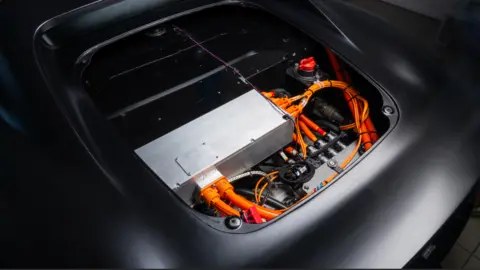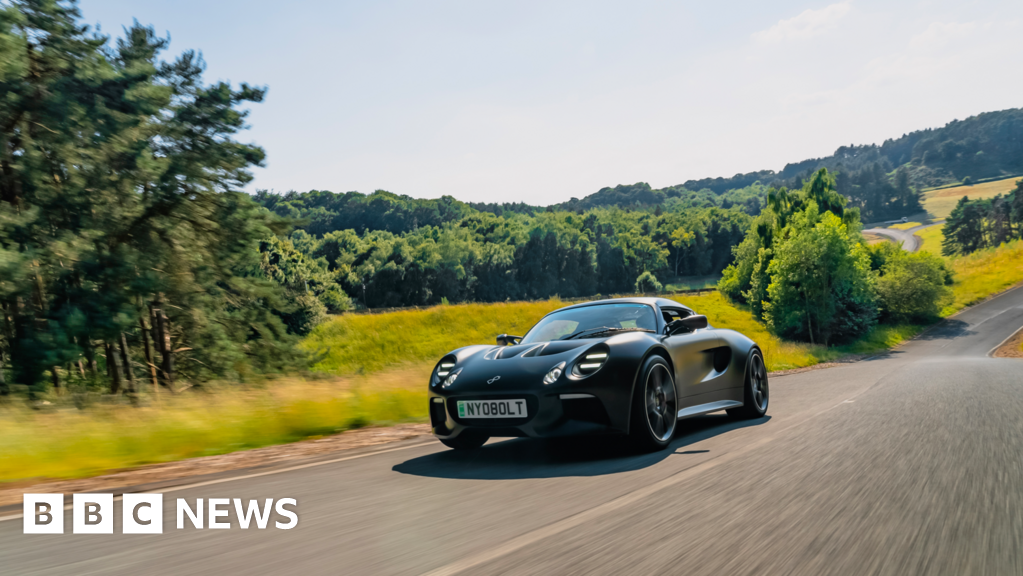By Zoe Kleinman, Technology editor
 Nyobolt
NyoboltAn electric car battery developed by UK start-up Nyobolt has successfully charged from 10% to 80% in four minutes and 37 seconds in its first live demonstration.
It was achieved with a specially-built concept sports car on a test track in Bedford, and is part of industry-wide efforts to get electric vehicles (EVs) charging more quickly.
By comparison, an existing Tesla supercharger can charge a car battery to 80% in 15-20 minutes.
Experts say eliminating so-called “range anxiety” is key to increasing uptake of EVs – but also stress the importance of improving the charging infrastructure.
“Developing technology that enables people to charge more quickly, which chimes with the time it currently takes to re-fuel a car – is really important,” Paul Shearing, Professor of Sustainable Energy Engineering at Oxford University, told the BBC.
But he added there needed to be more chargers of all types.
“People are going to want fast-charging infrastructure, independent of what car they’re using – everyone wants to do this more quickly,” he said.
The sports car the Nyobolt battery was fitted to – which was tested over two days this week – achieved a range of 120 miles after four minutes
A Tesla charged to 80% would typically have a range of up to 200 miles.
Dr Sai Shivareddy, co-founder of Nyobolt, told the BBC he was pleased with the results but admitted that the tests had been “nerve-wracking”.
The demo was carried out live in front of an invited audience of industry professionals for the first time – with a few hitches along the way.
Challenges included the UK heatwave, a failure in the concept car’s cooling system, and a standard on-site charger that was not made by Nyobolt.
These factors prevented the firm from recreating laboratory results, in which it says the battery can charge from 0% to 100% in six minutes.
Nonetheless, Dr Shivareddy described the event as “a big milestone for electrification”, and joked that his own car was still charging, having plugged it in when he arrived earlier that day.
 Nyobolt
NyoboltNyobolt says it does not intend to manufacture its own vehicles, and plans to partner with existing car brands, with the battery potentially inside EVs “at small scale” within a year.
The powerful 350kW DC superfast chargers that it requires are publicly available in the UK but are not yet widespread.
The firm also claims it has minimised degradation – it says the battery still charges to 80% after 4,000 cycles.
A full cycle is a charge from 0-100%, but this does not have to come all at once. For example, two charges of 50% would count as one cycle.
Apple says the iPhone 15 battery will have 80% functionality after 1,000 cycles.
 Nyobolt
NyoboltPower, weight and durability
There’s a global race to develop faster-charging batteries that are more powerful, lighter and durable.
Last year Toyota said a technical breakthrough would enable it to develop a solid state battery which could charge in ten minutes and last 1,200 km (754m).
And a compact charger developed by the US start-up Gravity can add 200 miles of range to an electric vehicle in under 13 minutes.
But Dr Edward Brightman, lecturer in chemical engineering at Strathclyde University, said that while rapid charging is useful for long journeys, the real barrier to electric vehicle take-up still lay in the supporting infrastructure.
“Electric cars really aren’t limited by the batteries anymore,” he said.
“We urgently need to upgrade the grid and deploy rapid chargers with the capability to deliver the charge to the battery.”


